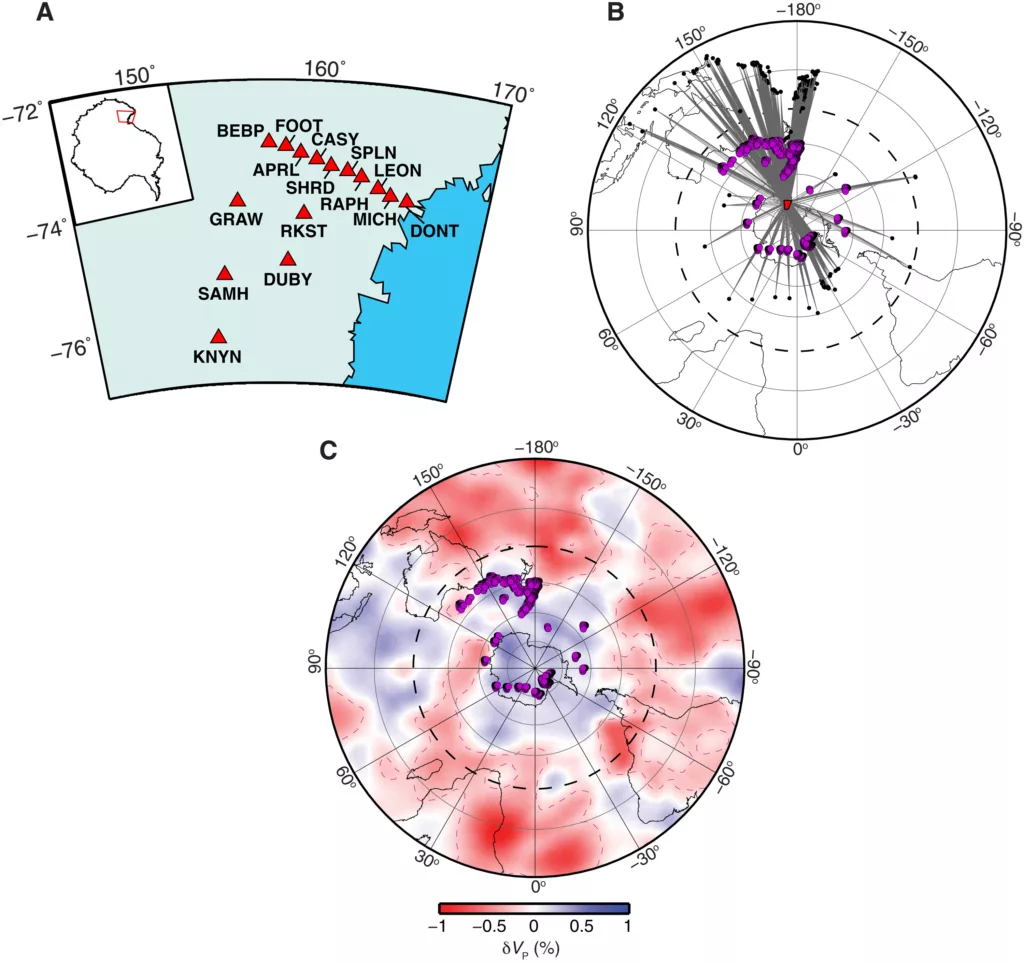Deep beneath our feet, Earth’s mantle hides secrets once considered unknowable. Today, seismologists look to large earthquakes that create body waves—P- and S-waves—that travel through solid Earth to be detected by seismic stations around the world. Such analyses have led to discoveries like the structure of Earth’s core, variations in the mantle, and a most peculiar feature that sits at the boundary between the two—ultralow velocity zones, or ULVZs. These are among the strangest structures inside Earth and their origins have been debated for decades—including a new paper in Science Advances led by Samantha Hansen, a professor at The University of Alabama.
“ULVZs likely play an important role in the plate tectonics cycle,” said Hansen. “For example, they may help control the temperature conditions at the core-mantle boundary, which strongly influences Earth’s magnetic field and the distribution of mantle plumes. Understanding ULVZs can help us to better constrain how the different components of Earth’s system are related to one another.”
In this new work, Hansen and colleagues found that ultralow velocity zones are widespread but varied along the core-mantle boundary in the Southern Hemisphere. Using mantle convection simulations, they demonstrated how previously subducted material could explain the existence of these weird zones dotting the core’s periphery.
Surprisingly slow zones
As the mantle convects, it carries heat upward from core to crust. Where hot mantle rises, geologists might expect to find a mid-ocean ridge producing new oceanic crust at the surface. Relatively cold subducting slabs continue the convection cycle as they descend down into the mantle, eventually reaching the core-mantle boundary after perhaps 100 million years, or more. “While this is a long time by human standards, it is a fairly rapid process for our 4.6 billion year old planet,” Hansen said.
In numerous studies, seismologists have imaged two major regions of mantle upwelling, called large low-velocity provinces, located beneath Africa and the Pacific Ocean. Using velocity, seismologists might infer temperature; for instance, colder material transmits seismic waves faster than hotter material. When modeled, large low-velocity provinces look like blobs unfurling multiple plumes up to the surface, and their surface manifestation might be volcanoes like those along the East African Rift, or the Ontong-Java Plateau in the south Pacific.
Ultralow velocity zones are just what their name implies—regions that have even slower seismic velocities than the much larger large low-velocity provinces. A mere 20% of the core-mantle boundary has been surveyed for the presence of these relatively small features.
Searching the Southern Hemisphere
In Hansen’s study, she and her team investigated a sector of the lowermost mantle left largely unexplored in previous studies. This region is neither within nor near those giant, blobby large low-velocity provinces beneath Africa and the Pacific Ocean. The Southern Hemisphere is also mostly devoid of recent or current subduction.
To explore details of the core-mantle boundary in this area, the team used seismic waves reflected off the core, called PcP waves, as recorded by the Transantarctic Mountains Northern Network (TAMNNET) that was deployed in Antarctica between 2012 and 2015. (These data are available via the SAGE Facility operated by EarthScope.) The PcP phases sampled a broad section of the core-mantle boundary beneath the Southern Hemisphere, allowing the team to expand greatly on prior work.

Of the 183 earthquakes recorded by TAMNNET that met the criteria for further assessment, 152 events showed evidence for ultralow velocity zones. Several appear in the vicinity of Australia and New Zealand, and others cluster around and near Antarctica.
In general, this region has higher-than-average seismic velocities, which could translate to cooler temperatures. Yet, these clusters of ultralow velocity zones belie a more complex picture.
Cold crust, moving mantle
Ultralow velocity zones, Hansen and colleagues posit, may be part of the large-scale mantle convection cycle. In other words, perhaps subduction of oceanic crust has something to do with these deep-seated features.
Though present-day and recent subduction occurs far from the study area, the authors note that subduction around the Pacific basin has been ongoing for at least the past 200 million years. To test whether formerly subducted materials could have been swept into the study region, Hansen and colleagues turned to geodynamic simulations that span these timescales. In the simulations, after about 150 million years, subducted material reaches the lowermost mantle and then migrates along the core-mantle boundary.
Based on these simulations as well as likely mineralogical compositions at depth, they conclude that the widespread distribution of ultralow velocity zones could be explained by subducted material accumulating at the core-mantle boundary relatively recently—during the past 200 million years—as opposed to via other mechanisms, like another hypothesis suggesting a far older origin related to Earth’s early differentiation. “We cannot rule out the possibility that some of that ancient material may still exist in the deep mantle,” said Hansen. “However, most of it was likely advected into mantle upwellings long ago and therefore may not exist outside the large low-velocity provinces today.”

